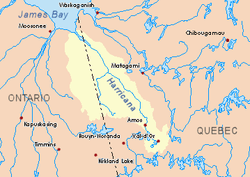Kenning River
The Kenning River is a tributary of the Case River, flowing into the Cochrane District, in Northeastern Ontario, in Canada . The course of this river crosses the townships of Kenning and Case.
| Kenning | |
|---|---|
 Harricana River basin in yellow | |
| Location | |
| Country | Canada |
| Province | Ontario |
| District | Cochrane |
| Physical characteristics | |
| Source | |
| • location | Cochrane District, Ontario |
| • coordinates | 49°08′26″N 79°56′40″W |
| • elevation | 309 m (1,014 ft) |
| Mouth | Case River |
• location | Cochrane District, Ontario |
• coordinates | 49°22′04″N 80°11′59″W |
• elevation | 294 m (965 ft) |
| Length | 19.1 km (11.9 mi)[1] |
Forestry is the main economic activity of the sector; recreational tourism activities, second.
The surface of the river is usually frozen from early November to mid-May, however, safe movement on ice is generally from mid-November to the end of April.
Geography
The surrounding hydrographic slopes of the Kenning River are:
- North side: Mikwam River, East Mikwam River;
- East side: Kabika River, East Kabika River, Case River;
- South side: Mace Creek, Abitibi Lake, Little Kaminisinakwa River;
- West side: Little Joe Creek, Seguin River.
The Kenning River originates at the mouth of Kenning Lake (length: 0.9 metres (2 ft 11 in); elevation: 309 metres (1,014 ft)) in the township of Case. Its mouth is located at 22.0 kilometres (13.7 mi) north of the North-West Bay of Abitibi Lake.
From the mouth of Kenning Lake, the Kenning River flows over 19.1 kilometres (11.9 mi) according to the following segments:
- 8.6 kilometres (5.3 mi) northeasterly in the township of Case, to the boundary of Kenning Township;
- 5.3 kilometres (3.3 mi) northeasterly in Kenning Township to a bend in the river;
- 3.2 kilometres (2.0 mi) south-east to a bend in the river;
- 2.0 kilometres (1.2 mi) northeasterly to mouth.[2]
The confluence of the Kenning River in Kenning Township, to:
- 31.2 kilometres (19.4 mi) west of the Ontario - Quebec border;
- 10.8 kilometres (6.7 mi) south-west of the mouth of the Case River (confluence with the Kabika River);
- 27.1 kilometres (16.8 mi) southwesterly of the mouth of the Kabika River (confluence with the Burntbush River);
- 41.2 kilometres (25.6 mi) southwesterly of the mouth of the Burntbush River (confluence with the Turgeon River);
- 28.8 kilometres (17.9 mi) north of Northwest Bay of Abitibi Lake.
Toponymy
The term "Kenning" is a family name of English origin.
See also
- River Case, a watercourse
- Kabika River, a watercourse
- Burntbush River, a watercourse
- Turgeon River, a watercourse
- Harricana River, a watercourse
- James Bay
- Cochrane District (Ontario)
- Northeastern Ontario
- List of rivers of Ontario
References
- Atlas of Canada
- Distances from the Department of Natural Resources Canada's Atlas of Canada (published on the Internet).